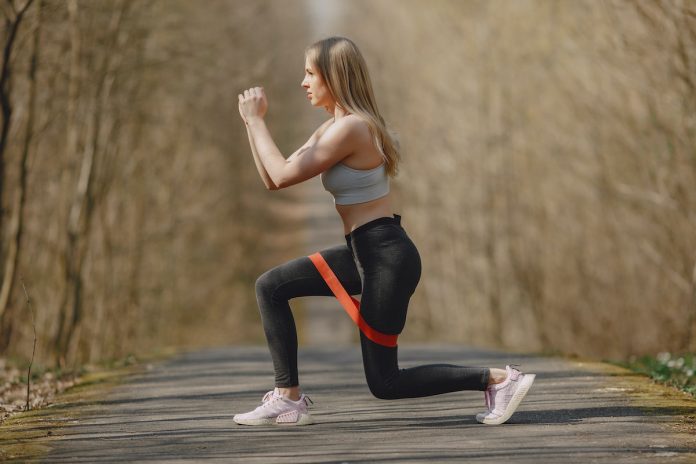Rita Ora crushes fitness the same way she crushes singing, songwriting, and the red carpet. Which is to say, flawlessly.
For evidence, see an Instagram video posted yesterday by celebrity trainer Ben Bruno in which the British pop star-slash-actress tackles a set of weighted reverse lunges with perfect form.
Reverse lunges challenge many muscles in your lower body, primarily the glutes, hamstrings, quads, and calves. They tend to be more beginner-friendly than forward lunges—since the fixed leg bears most of the weight, they’re typically easier to do in a controlled manner.
Yet common form errors—including letting the front knee extend beyond the toes, not bending both knees 90 degrees, and stepping too far forward or too far back with the moving leg—can prevent exercisers from reaping the backside-strengthening benefits (plus other benefits) of the reverse lunge. The resistance band helps address and correct all of these, says Mansour. If you’re using the band as intended, “it’s impossible to complete the exercise incorrectly,” she explains.
How does that work? The goal with the band, explains Mansour, is to maintain constant tension as you perform the reps. If you feel any slackening in the tension, you’ll know that something is amiss with your form.
Part of keeping this tension involves pressing down through the heel of the front leg, which will ensure that you are primarily working the back of that leg—versus the front—which would be the case if you just pushed down through your toes.
The placement of the band will also prevent your front knee from extending beyond your toes—another reverse lunging no-no, as it places the bulk of the tension on the front of your legs rather than the back. Over time, this can place undue stress on your knee, says Mansour. By keeping both the weight in your heel and preventing your front knee from going beyond your toes, your back will remain upright, extended, and in a more stable position, adds Matt Kite, certified strength and conditioning specialist and director of education for fitness franchise D1 Training. From here, you’ll be able to better nail the desired 90-degree angle with both legs.
As Bruno says in the comments underneath his post: “Adding the band is a great way to take stress off the knees and put more emphasis on the glutes, as you’re able to step back further and maintain a vertical shin position.”
Lastly, the band helps cue your back foot to land in the correct position with each step. “In a reverse lunge, people can step back too far or too little,” Mansour explains. But with the band, “you couldn’t physically step back too far, because the band would restrict that, and you couldn’t step back too little, because the front knee would go forward and the band would get flimsy,” she explains. In other words, “the band helps you find that sweet spot.”
In general, this tool doesn’t automatically make the move harder. It does, however, make it easier for you to perform reverse lunges with better form, which will help you really feel the work and get the most out of the movement, says Mansour. The benefits include strengthening the backside, as mentioned, as well as muscles surrounding the knee and ankle joints. Reverse lunges also work the core—including the rectus abdominis (what you think when you think abs) and transverse abdominis (the deepest core muscle that wraps around the sides and spine). On top of that, if you perform the move while holding a weight like Ora, your arms, back, and shoulders will be challenged as well, says Mansour, making it a total-body strengthening move.
Here’s how to do the weighted banded reverse lunges:
- Take a sturdy, looped resistance band and wrap one end around your right leg, just below the knee, and loop the other end around a stable object, like the leg of a table, bench, or couch, suggests Mansour.
- Grab a light to medium weight (you can use a kettlebell, like Ora, or a dumbbell or plate), grip it with both hands, and hold it at chest level.
- Step back so that the band pulls straight. You should feel slight tension in the band.
- From here, stand with your feet shoulder-width apart.
- Step back (about 2 feet) with your left foot, landing on the ball of your left foot and keeping your heel off the ground. Make sure you still feel tension in the band from this position.
- Bend both knees to create two 90-degree angles with your legs.
- Your shoulders should be directly above your hips and your chest should be upright. Your right shin should be perpendicular to the floor and your right knee should be stacked above your right ankle. Your butt and core should be engaged.
- Push through the heel of your right foot to stand back up, making sure that you maintain tension in the band as you move.
- This is 1 rep. Do 10 reps. Switch legs, placing the resistance band around your left leg, and do another 10 reps.
You can do these lunges as a standalone set or add them to a larger lower-body workout by interspersing 3 sets of 10 reps on each leg with other exercises, suggests Mansour.
As mentioned, if the tension comes off the band at any part of the move, that’s a sign you need to check your form. Also, make sure the band stays directly below your knee as you perform the reps. If it’s folding or moving with each rep, that’s a sign that it’s likely placed up too high onto your actual knee. Readjust as needed.
Lastly, know that however many lunges you attempt, if you follow the above directions, you’ll crush them with stellar form—just like Ora.


























